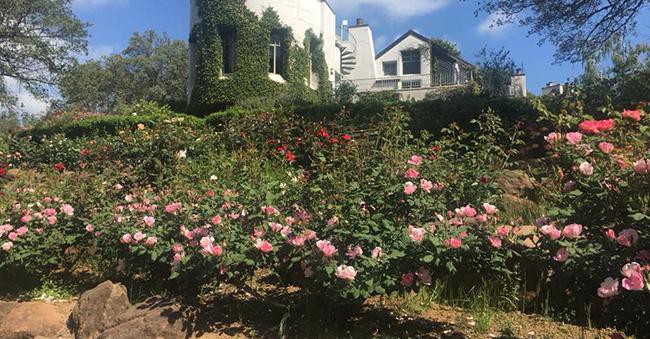
See Poswalls' Springhill near Lincoln and a hidden Newcastle oasis

Springhill, the gardens of John Poswall and Peg Tomlinson Poswall, will open for visitors Sunday. Courtesy Poswall Gardens
“If only I had room!” Every gardener has had that thought.
Here’s an opportunity to see two amazing and imaginative private gardens in Placer County created by folks who had enough room to let their dreams really grow. One garden – the Poswalls’ Springhill – sprawls over 50 oak-studded acres near Lincoln; the other – a 3-acre oasis outside Newcastle – has never been shared on a public tour.
Both gardens will welcome visitors from 10 a.m. to 4 p.m. Sunday, June 4, during The Garden Conservancy’s Open Garden Days. These two participating gardens are about 20 minutes apart.
Suggested donation is $10 per garden per person. Patrons may sign up for one garden or both, but advance registration is a must. Sign up here.
The Garden Conservancy’s Open Garden Days program “annually celebrates the country’s most exciting, creative, and innovative private gardens,” says the conservancy. “Open Days is made up of a nationwide community of gardeners and garden enthusiasts teaching and inspiring each other and the public. From expert to novice, there is no better way to improve as a gardener than by experiencing a diverse range of gardens, and gardening traditions, firsthand.”
These two Placer County gardens are excellent examples.
Created by novelist/attorney John Poswall and his wife, food expert Peg Tomlinson Poswall, Springhill is not one garden but more than 20. It’s a rare collection of whimsy inspired by the couple’s world travels, complete with its own Stonehenge.
“Start at the Chinese Garden, hidden away below levies, with its Hidden Buddha Garden, Xi'An warrior, and Lotus Pond, and exit at waterfalls,” suggest the organizers. “Walk the plant-covered Islamic arched pergola to the Mexican Garden with its palapa and palms, and then on to the 400-foot-long Statuary Garden lined with Italian cypress; St. Michael at the top, the Three Graces at the bottom, and a 19-foot-high fountain in between. Above is the Italian Garden and still higher the Rose Garden with a view of the house and tower.”
In between are cactus and drought-tolerant gardens as well as lotus-filled ponds and shady retreats. Wear comfortable shoes.
The second stop is also special. Nicknamed Cheryl’s Oasis, this 3-acre private garden has been 47 years in the making. Located off Highway 193, just west of Newcastle, the property features a series of garden “rooms”; at the center is a screened-in sleeping room – open to nature. A highlight is the gardener’s vast collection of succulents, grown for three decades.
“More than 100 species and varieties of plants, flowering bushes, and trees surround the home with a mixed feeling of cactus, ferns, bamboo, and yucca crowding pathways lined with succulents, agave, and aloe,” say the organizers. “Pine trees and fruit trees sit alongside Chinese fringe and tulip trees with red canna below. … All this, in a distinct sense of quiet and peace.”
See for yourself – but one day only.
For more details: https://www.gardenconservancy.org/
Comments
0 comments have been posted.Sacramento Digs Gardening to your inbox.
Sites We Like
Garden Checklist for week of July 21
Your garden needs you!
* Keep your vegetable garden watered, mulched and weeded. Water before 8 a.m. to reduce the chance of fungal infection and to conserve moisture.
* Feed vegetable plants bone meal, rock phosphate or other fertilizers high in phosphate to stimulate more blooms and fruiting. (But wait until daily high temperatures drop out of the 100s.)
* Don’t let tomatoes wilt or dry out completely. Give tomatoes a deep watering two to three times a week.
* Harvest vegetables promptly to encourage plants to produce more. Squash especially tends to grow rapidly in hot weather. Keep an eye on zucchini.
* Pinch back chrysanthemums for bushy plants and more flowers in September.
* Remove spent flowers from roses, daylilies and other bloomers as they finish flowering.
* Pinch off blooms from basil so the plant will grow more leaves.
* Cut back lavender after flowering to promote a second bloom.
* It's not too late to add a splash of color. Plant petunias, snapdragons, zinnias and marigolds.
* From seed, plant corn, pumpkins, radishes, winter squash and sunflowers.